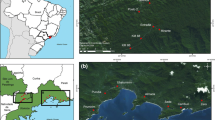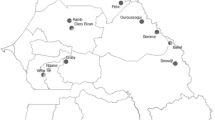Abstract
In order to clarify the genetic differentiation and reproductive traits of mixed polyploid populations in Parasenecio kamtschaticus complex, geographical distribution, genetic diversity, and reproductive performance were compared among three intraspecific types composed of two cytotypes and two varieties in Japan. Diploid P. kamtschaticus var. kamtschaticus (2×-kamtschaticus) was distributed at the center of the distribution range, tetraploid P. kamtschaticus var. kamtschaticus (4×-kamtschaticus) existed widely throughout the entire range, and tetraploid P. kamtschaticus var. bulbifera (4×-bulbifera), producing bulbils, was restricted to higher elevations. Genetic structure was analyzed using allozyme markers. The genetic diversity of 4×-kamtschaticus was higher than that of 2×-kamtschaticus, with that of 4×-bulbifera being intermediate. Populations of 4×-bulbifera and 2×-kamtschaticus were genetically discriminable from each other in principle coordinate analysis, and the genetic structure of 4×-kamtschaticus populations largely overlapped with those of the other types. Flower and achene production levels were highest in the 4×-kamtschaticus populations and lowest in the 4×-bulbifera populations. Germination activity of achenes was highest in the 2×-kamtschaticus populations and lowest in the 4×-bulbifera populations. Fruit-set success of 4×-bulbifera decreased with elevation because of a shorter growing season, indicating the importance of vegetative reproduction by bulbils at higher elevations. Unexpectedly, the inbreeding coefficients of the 4×-bulbifera populations were the lowest among the three types. Occasional achene production by outcrossing might maintain the high genetic diversity of the 4×-bulbifera populations. The evolution of polyploidy and subsequent bulbil production might enable P. kamtschaticus to disperse a wider range of environmental conditions.




Similar content being viewed by others
References
Adams K, Wendel J (2005) Polyploidy and genome evolution in plants. Curr Opin Pl Biol 8:135–141. https://doi.org/10.1016/j.pbi.2005.01.001
Barringer BC (2007) Polyploidy and self-fertilization in flowering plants. Amer J Bot 94:1527–1533. https://doi.org/10.3732/ajb.94.9.1527
Birchler JA, Yao H, Chudalayandi S, Vaiman D, Veitia RA (2010) Heterosis. Pl Cell 22:2105–2112. https://doi.org/10.1105/tpc.110.076133
Borgen L, Hultgård UM (2003) Parnassia palustris: a genetically diverse species in Scandinavia. Bot J Linn Soc 142:347–372. https://doi.org/10.1046/j.1095-8339.2003.00186.x
Brochmann C, Brysting AK, Alsos IG, Borgen L, Grundt HH, Scheen A-C, Elven R (2004) Polyploidy in arctic plants. Biol J Linn Soc 82:521–536. https://doi.org/10.1111/j.1095-8312.2004.00337.x
Burton TL, Husband B (2000) Fitness differences among diploids, tetraploids, and their triploid progeny in Chamerion angustifolium: mechanisms of inviability and implications for polyploidy evolution. Evolution 54:1182–1191. https://doi.org/10.1111/j.0014-3820.2000.tb00553.x
Chung MY, López-Pujol J, Chung JM, Kim K-J, Park SJ, Chung MG (2015) Polyploidy in Lilium lancifolium: evidence of autotriploidy and no niche divergence between diploid and triploid cytotypes in their native ranges. Flora 213:57–68. https://doi.org/10.1016/j.flora.2015.04.002
Comai L (2005) The advantages and disadvantages of being polyploidy. Nat Rev Genet 6:836–846. https://doi.org/10.1038/nrg1711
Cosendai A-C, Wagner J, Lading U, Rosche C, Hörandl E (2013) Geographical parthenogenesis and population genetic structure in the alpine species Ranunculus kuepferi (Ranunculaceae). Heredity 110:560–569. https://doi.org/10.1038/hdy.2013.1
Diggle PK, Lower S, Ranker TA (1998) Clonal diversity in alpine populations of Polygonum viviparum (Polygonaceae). Int J Pl Sci 159:606–615. https://doi.org/10.1086/297579
Duchoslav M, Stanková H (2015) Population genetic structure and clonal diversity of Allium oleraceum (Amaryllidaceae), a polyploid geophyte with common asexual but variable sexual reproduction. Folia Geobot 50:123–136. https://doi.org/10.1007/s12224-015-9213-0
Ellstrand NC, Roose KL (1987) Patterns of genotypic diversity in clonal plant species. Amer J Bot 74:123–131. https://doi.org/10.1002/j.1537-2197.1987.tb08586.x
Gabrielsen TM, Brochmann C (1998) Sex after all: high levels of diversity detected in the arctic clonal plant Saxifraga cernua using RAPD markers. Molec Ecol 7:1701–1708. https://doi.org/10.1046/j.1365-294x.1998.00503.x
Hardy OJ, Vekemans X (2001) Patterns of allozyme variation in diploid and tetraploid Centaurea jacea at different spatial scales. Evolution 55:943–954. https://doi.org/10.1111/j.0014-3820.2001.tb00612.x
Hardy OJ, Vekemans X (2002) Program note SPAGEDI: a versatile computer program to analyse spatial genetic structure at the individual or population levels. Molec Ecol Notes 2:618–620. https://doi.org/10.1046/j.1471-8286.2002.00305.x
Hegarty ML, Hiscock SJ (2008) Genomic clues to the evolutionary success of polyploid plants. Curr Biol 18:435–444. https://doi.org/10.1016/j.cub.2008.03.043
Husband BC, Sabara HA (2003) Reproductive isolation between autotetraploids and their diploid progenitors in fireweed, Chamerion angustifolium (Onagraceae). New Phytol 161:703–713. https://doi.org/10.1046/j.1469-8137.2004.00998.x
Husband BS, Schemske D (1997) The effect on inbreeding in diploid and tetraploid populations of Epilobium angustifolium (Onagraceae): implications for the genetic basis of inbreeding depression. Evolution 51:737–746. https://doi.org/10.1111/j.1558-5646.1997.tb03657.x
Jiao Y, Wickett NJ, Ayyampalayam S, Chanderbali AS, Landherr L, Ralph PE, Tomsho LP, Hu Y, Liang H, Soltis PS, Soltis DE, Clifton SW, Schlarbaum SE, Schuster SC, Ma H, Leebens-Mack J, de Pamphilis CW (2011) Ancestral polyploidy in seed plants and angiosperms. Nature 473:97–100. https://doi.org/10.1038/nature09916
Jombart T (2008) adegenet: a R package for the multivariate analysis of genetic markers. Bioinformatics 24:1403–1405. https://doi.org/10.1093/bioinformatics/btn129
Kirchheimer B, Schinkel CCF, Dellinger AS, Klatt S, Moser D, Winkler M, Lenoir J, Caccianiga M, Gusian A, Nieto-Lugilde D, Svenning J-C, Thuiller W, Vittoz P, Willner W, Zimmermann NE, Hörandl E, Dullinger S (2016) A matter of scale: apparent niche differentiation of diploid and tetraploid plants may depend on extent and grain of analysis. J Biogeogr 43:716–726. https://doi.org/10.1111/jbi.12663
Koch M, Bernhard K-G (2004) Comparative biogeography of the cytotypes of annual Microthlaspi perfoliatum (Brassicaceae) in Europe using isozymes and cpDNA data: refugia, diversity centers, and postglacial colonization. Amer J Bot 91:115–124. https://doi.org/10.3732/ajb.91.1.115
Kudo G, Ida TY, Tani T (2008) Linkages between phenology, pollination, photosynthesis, and reproduction in deciduous forest understory plants. Ecology 89:321–331. https://doi.org/10.1890/06-2131.1
Moody ME, Mueller LD, Soltis DE (1993) Genetic variation and random drift in autotetraploid populations. Genetics 134:649–657
Murray BG, Young AG (2001) Widespread chromosome variation in the endangered grassland forb Rutidosis leptorrhynchoides F. Muell. (Asteraceae: Gnaphalieae). Ann Bot (Oxford) 87:83–90. https://doi.org/10.1006/anbo.2000.1307
Nakagawa M (2006) Ploidy, geographical distribution and morphological differentiation of Parasenecio auriculata (Senecioneae; Asteraceae) in Japan. J Pl Res 119:51–61. https://doi.org/10.1007/s10265-005-0239-x
Nielsen R, Tarpy DR, Reeve HK (2003) Estimating effective paternity number in social insects and the effective number of alleles in a population. Molec Ecol 12:3157–3164. https://doi.org/10.1046/j.1365-294X.2003.01994.x
Otto SP, Whitton J (2000) Polyploid incidence and evolution. Annual Rev Genet 34:401–437. https://doi.org/10.1146/annurev.genet.34.1.401
Pluess AR, Stöcklin J (2005) The importance of population origin and environmental on clonal and sexual reproduction in the alpine plant Geum reptans. Funct Ecol 19:228–237. https://doi.org/10.1111/j.0269-8463.2005.00951.x
Ramsey J, Schemske DW (2002) Neopolyploidy in flowering plants. Annual Rev Ecol Evol Syst 33:589–639
Ronfirt J, Jenczewski E, Bataillon T, Rousset F (1998) Analysis of population structure in autotetraploid species. Genetics 150:921–930
Rosche C, Durka W, Hensen I, Mráz P, Hartmann M, Müller-Schärer H, Lachmuth S (2016) The population genetics of the fundamental cytotype-shift in invasive Centaurea stoebe s.l.: genetic diversity, genetic differentiation and small-scale genetic structure differ between cytotypes but not between ranges. Biol Invas 18:1895–1910. https://doi.org/10.1007/s10530-016-1133-2
Schinkel CCF, Kirchheimer B, Dellinger AS, Klatt S, Winkler M, Dullinger S, Hörandl E (2016) Correlations of polyploidy and apomixis with elevation and associated environmental gradients in an alpine plant. AoB Plants 8:10.1093/aobpla/plw064. https://doi.org/10.1093/aobpla/plw064
Soltis PS, Soltis DE (2000) The role of genetic and genomic attributes in the success of polyploids. Proc Natl Acad Sci USA 97:7051–7057. https://doi.org/10.1073/pnas.97.13.7051
Soltis DE, Soltis PS, Tate JA (2003) Advances in the study of polyploidy since plant speciation. New Phytol 161:173–191. https://doi.org/10.1046/j.1469-8137.2003.00948.x
Soltis PS, Marchant DB, Van de Peer Y, Soltis DE (2015) Polyploidy and genome evolution in plants. Curr Opin Genet Developm 35:119–125. https://doi.org/10.1016/j.gde.2015.11.003
Stebbins GL (1950) Variation and evolution in plants. Columbia University Press, New York
Steiner BL, Armbruster GFJ, Scheepens JF, Stöcklin J (2012) Distribution of bulbil- and seed-producing plants of Poa alpina (Poaceae) and their growth and reproduction in common gardens suggest adaptation to different elevations. Amer J Bot 99:2035–2044. https://doi.org/10.3732/ajb.1200213
Stöcklin J, Kuss P, Pluess AR (2009) Genetic diversity, phenotypic variation and local adaptation in the alpine landscape: case studies with alpine plant species. Bot Helv 119:125–133. https://doi.org/10.1007/s00035-009-0065-1
Wang C-N, Möller M, Cronk QCB (2004) Population genetic structure of Titanotrichum oldhamii (Gesneriaceae), a subtropical bulbiliferous plant with mixed sexual and asexual reproduction. Ann Bot (Oxford) 93:201–209. https://doi.org/10.1093/aob/mch028
Weppler T, Stoll P, Stöcklin J (2006) The relative importance of sexual and clonal reproduction for population growth in the long-lived alpine plant Geum reptans. J Ecol 94:869–879. https://doi.org/10.1111/j.1365-2745.2006.01134.x
Wood TE, Takebayashi N, Barker MS, Mayrose Greenspoond PB, Rieseberg LH (2009) The frequency of polyploid speciation in vascular plants. Proc Natl Acad Sci USA 106:13875–13879. https://doi.org/10.1073/pnas.0811575106
Young AG, Hill JH, Murray BG, Peakall R (2002) Breeding system, genetic diversity and clonal structure in the sub-alpine forb Rutidosis leiolepis F. Muell. (Asteraceae). Biol Conservation 106:71–78. https://doi.org/10.1016/S0006-3207(01)00230-0
Yu F, Kress WJ, Gao JY (2010) Morphology, distribution, and chromosome counts of two varieties of Hedychium villosum (Zingiberaceae). J Syst Evol 48:344–349. https://doi.org/10.1111/j.1759-6831.2010.00094.x
Acknowledgements
We sincerely thank Makoto Kobayashi for his help with the allozyme analysis, Masato Nakagawa for valuable information on the cytotype distributions of Parasenecio kamtschaticus in Hokkaido, and two anonymous reviewers for their valuable comments. This study was partly supported by JSPS KAKENHI 18H02504.
Author information
Authors and Affiliations
Contributions
GK planned this study and wrote the first draft of the paper, GK and ASH conducted the field survey, analyzed the data, discussed the results, and prepared the final version of this paper.
Corresponding author
Ethics declarations
Conflict of interest
The authors declare that they have no conflict of interest.
Additional information
Handling Editor: Hiroshi Kudoh.
Publisher's Note
Springer Nature remains neutral with regard to jurisdictional claims in published maps and institutional affiliations.
Information on Electronic Supplementary Material
Below is the link to the electronic supplementary material.
Information on Electronic Supplementary Material
Information on Electronic Supplementary Material
Online Resource 1. a Parasenecio kamtschaticus var. kamtschaticus and b P. kamtschaticus var. bulbifera at the flowering stage
Online Resource 2. Banding patterns of seven loci observed in individuals of Parasenecio kamtschaticus cytotypes. The identified genotype is shown in each band for diploid (lower) and tetraploid (upper). SKD: shikimic acid dehydrogenase, PGM: phosphoglucomutase, EST: esterase, and LAP: leucine aminopeptidase.
Online Resource 3. Photographs of zymogram patterns of four enzyme systems. a SKD: shikimic acid dehydrogenase, b PGM: phosphoglucomutase, c EST: esterase, and d LAP: leucine aminopeptidase.
Rights and permissions
About this article
Cite this article
Kudo, G., Hirao, A.S. Geographical distribution, genetic diversity, and reproductive traits of mixed polyploid populations in Parasenecio kamtschaticus (Senecioneae; Asteraceae). Plant Syst Evol 306, 86 (2020). https://doi.org/10.1007/s00606-020-01714-3
Received:
Accepted:
Published:
DOI: https://doi.org/10.1007/s00606-020-01714-3




